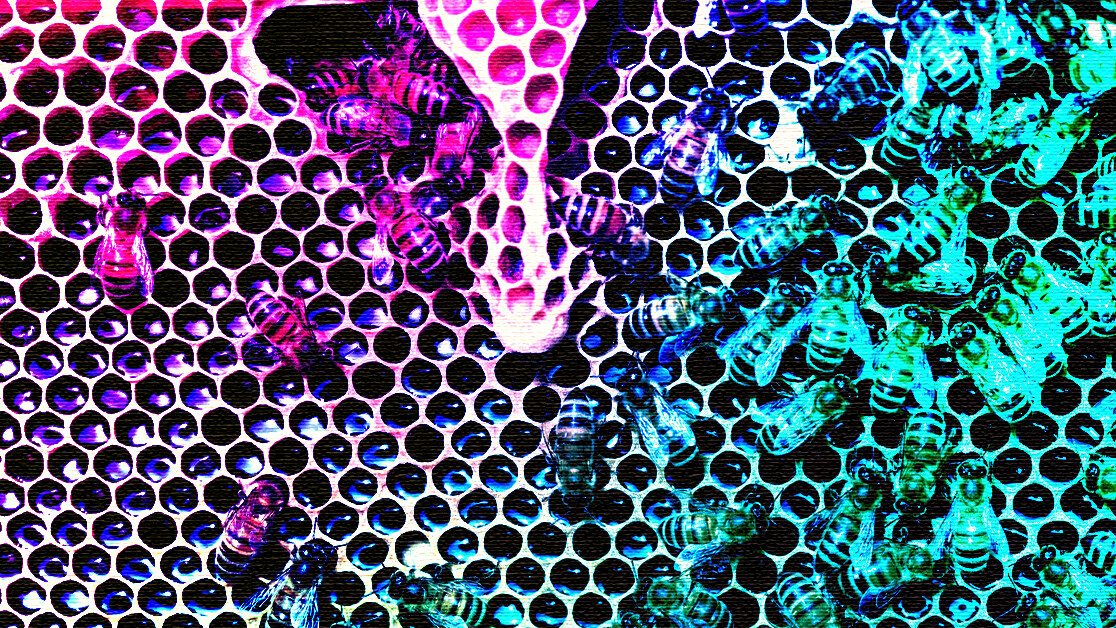
Did you know Warren Knight, the author of this piece, is speaking at TNW2020 this year? Check out their session on ‘What’s next for the digital-first mindset?’ here.
What do bees have in common with teams in the digital workplace?
When I’m talking to leaders in business, it’s often helpful to use analogies to help them relate to workplace challenges and look at things from an alternative angle. And since moving to the countryside a couple of years ago, I’ve found observing my 50,000 bees particularly thought-provoking.
Watching bees is a humbling experience. To start with, their movements may seem and random, but as you get to know them, you begin to identify the patterns in their movements, and see that they are actually buzzing around according to a carefully co-ordinated plan. We talk about ‘busy little bees’ for a reason.
What beekeeping taught me about digital leadership
Although I’ve spent many hours watching my bees, I haven’t made any scientific studies of them (yet). But there are several studies and stories out there that highlight what bees can teach us about leadership in business, so it’s given me a great deal to think about.
Here are some of my favorite lessons from bees.
Teams thrive on honest communication and information sharing
Bees are great communicators, using vibrations and pheromones to help pass complex messages. We have so many more communication options open to us, but how they’re used is vital. When you’re thinking about how to use digital technology for fast, efficient communication, remember that clarity, honesty and focus are essential.
The key to success lies in co-operation
A group of individuals acting together towards achieving a common goal makes much more possible than those individuals would be capable of alone. Keeping those individuals engaged means giving them a degree of autonomy within clear boundaries. And remember that, as leader, your importance doesn’t outweigh theirs.
Division of labor, thorough training, and multi-skilling
Bees take on a number of different roles in the hive during their lifetime. So they know how to perform a range of different tasks and, in an emergency, can revert to previous jobs and help out. Ensuring that your workforce is multi-skilled is one of the keys to building a flexible and adaptable business culture.
Planning for and protecting the future
Bees have to make their honey when they can – when there’s pollen around them. So they store their extra honey for the lean times, to make sure there’s food for the hive. Planning, transforming and innovating within your hive are essential to ensure a prosperous future.
But here’s another important lesson from bees. When a particularly rich source of nectar is discovered, the entire colony doesn’t immediately rush off to collect it. Bees don’t exclusively exploit the best flower patches, mining them until they run dry. They know that the supply won’t be there forever, and that they need to continue to seek other productive sites, because to rely on one would ultimately result in starvation. The colony allocates resources accordingly – some to collect nectar where it’s known, and others to seek out new sources.
Distribution of authority
When we imagine the ‘Queen Bee’ at the centre of the hive, we tend to see her being served by the workers who bring home the nectar. But she, too, is serving the future of the hive by laying the eggs that will ensure their survival. It’s a two-way relationship – everyone in the team carrying out their own role in serving a common goal to ensure they thrive in the future. Is that how you see your leadership style?
Equally, with tens of thousands of workers (there are 50,000 bees in my hives) the Queen isn’t the only leader. Whilst she may be the heart of the hive, she can’t possibly direct all operations personally. She relies on decentralized ‘managers’ to make appropriate decisions. For that to work, in the hive (or in your organization), there have to be several factors at work – clear objective, shared and understood by all the workers; rapid and effective communication that translates into action; and total reliability from the workforce.
Being prepared for changes in leadership
In his book ‘The Wisdom of Bees’, beekeeper, management consultant and professor, Michael O’Malley, tells us that ‘a colony headed by a high-quality queen has a more robust worker population and greater honey yield. It matters a great deal who is at the top. Consequently, it is not surprising that the workers in the hive pay close attention to the queen’s ability to propagate and are sensitive to declines in her performance. The queen’s ability to lead is determined ultimately by the minions, a truth unfortunately lost in many organizations.’
What does this mean for your organization? First, that the success of its leadership will depend on how willing the workers are to follow. Second, that organizations cannot survive without a leader and, in the case of bees, the colony plans for successors before they are actually needed.
O’Malley has something else to say that I love: “As you look for ways to improve your organization, it would not be outlandish to take a step back and ask yourself, ‘What would a bee do?’”
There’s one more great story that I’d like to share with you about lessons we can learn from observing and interacting with bees.
Jennifer Deal at the Center for Creative Leadership writes about her experience when a swarm of bees moved, uninvited, into her garden. She needed to find them a new home, but the professionals she contacted initially didn’t offer much help other than destroying the hive. Jennifer was determined to find a better solution, so she tapped into her local network. Bees, of course, are excellently networked – it’s how they communicate and get things done. And, as it turned out, so was Jennifer. She was reminded that knowing who does what and how to ask for help is vital to getting things done, and that seeking out that help results in stronger networks.
You can read Jennifer’s complete story here, but here’s my take on the three main lessons she learned:
Lesson 1: Explore your network to find a solution, but don’t forget to look outside it as well. Asking questions may well turn up unexpected ideas and solutions in places you weren’t anticipating.
Lesson 2: Be prepared to offer your help, too. Part of being an effective leader is to be generous with your assistance and support, and by using your network you may find ways to help that you hadn’t thought about.
Lesson 3: Expect the unexpected. You can’t predict everything that’s going to happen, but developing your own and your organization’s resilience and remaining open to opportunity makes you more likely to respond positively – and potentially able to turn a problem into an opportunity.
I’m a professional speaker, certified trainer, coach – and beekeeper. My first child was born in 2017 after 3 rounds of fertility treatment, and my second in 2018. With my family growing, I decided that going back to nature needed to play a massive part in our lives. So we moved to the country and now our ‘family’ includes 50,000 bees and four chickens. Along with about 100 lbs of honey and 1,280 eggs every year, my kids enjoy a lifestyle that involves what we call our ‘edible garden’, where we grow fruit and veg including strawberries, apples, pears, rhubarb, potatoes, tomatoes and a variety of herbs.
This article was originally published on Warren Knight’s blog. You can read it here.
Get the TNW newsletter
Get the most important tech news in your inbox each week.




